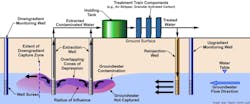Remediation of PFAS (per- and polyfluoroalkyl substances) contamination in groundwater imposes a complex challenge for airport operators worldwide. Part of this challenge stems from there being few options available for treating migrating PFAS groundwater plumes. And of the viable approaches, using ex-situ, pump-and-treat systems to contain these plumes may indirectly lead to future liability risks for airports and other responsible parties.
The potential increase in downstream liabilities due to the handling, transport, and disposal of PFAS-laden waste products is an important factor for airports to consider when selecting a remedy to contain PFAS-impacted groundwater plumes.
In situ remediation with colloidal activated carbon (CAC) is an effective, proven approach that stops PFAS contaminant plumes directly in the subsurface. Unlike ex-situ systems that transfer contaminants to aboveground waste streams, in situ CAC treatments avoid generating wastes that create potential new exposures and downstream liability risks.
Containing PFAS: Eliminating the Exposure to Remove the Risk
Remedies to contain PFAS are deployed either belowground or aboveground, referred to as ex-situ or in situ treatment. Both forms of containment aim to remove the possibility of exposure downstream. By removing the exposure pathway, such as a PFAS contaminant plume migrating toward a community water well, the risk to potential downgradient receptors is also removed.
There is a crucial difference in how PFAS plumes are contained. The ex-situ approach is a hydraulic containment method that focuses on stopping groundwater movement to contain the plume. Conversely, the in situ approach allows the water to pass through while retaining the PFAS in the CAC-treated zone.
Passively capturing a tiny amount of PFAS requires almost no energy compared to the energy input needed to hydraulically contain the massive volume of water in a typical PFAS contaminant plume, requiring decades of continuous pumping. Thus, the containment approaches are worlds apart regarding cost-effectiveness and sustainability. And only the in situ approach ensures communities do not become exposed to PFAS in new ways.
In Situ Remediation: Filtering Belowground to Remove PFAS Risk
In situ PFAS remediation entails constructing a subsurface filter with patented CAC adsorbent materials (e.g., PlumeStop and SourceStop) to remove PFAS from groundwater as it naturally flows through a treated zone. The process effectively immobilizes PFAS, preventing the contaminants from reaching drinking water wells or surface waters and keeping them belowground.
CAC comprises activated carbon sourced from coconuts, milled into red-blood-cell-sized particles, and suspended in a food-safe solution to create a liquid, colloidal form of highly reactive carbon. Ink-like in appearance, this novel, patented material slips through tiny openings, or pores, in the soil or rock and coats these aquifer materials with highly reactive carbon. The result is an expansive filtration surface, covering 100 acres per pound, that removes PFAS on contact.
These subterranean CAC filters are designed to immobilize PFAS over the long term based on site-specific modeling of contaminants, hydrology, and treatment goals. Optimized in situ treatments can offer a permanent PFAS risk removal solution.
The in situ approach's effectiveness has been demonstrated in numerous peer-reviewed research studies and is backed by PlumeShield, the industry's only warranty program for the in situ remediation of PFAS, alleviating any risk of non-performance.
Ex Situ Remediation: Moving PFAS Aboveground Opens New Potential Exposure Routes
Groundwater ex-situ treatment solutions for PFAS involve pumping PFAS-contaminated water aboveground to be filtered. This process generates waste and inadvertently introduces potential new routes of PFAS exposure. For example, pumping and treating PFAS-contaminated groundwater with granular activated carbon (GAC), the most common filtration material, relocates PFAS from a water medium belowground to a carbon medium aboveground.
These carbon wastes become saturated with PFAS and must be changed periodically to prevent contaminant breakthroughs, usually every few months. Each changeout cycle produces tons of PFAS-soaked GAC wastes that must be disposed of in a landfill or treated by incineration. This PFAS waste production is unceasing over the operational lifespan of a system, which may persist for generations. Many of these systems, once installed, have no determined endpoint for decommissioning.
In a landfill, PFAS can leach out of the impacted GAC. The leachate either passes from the landfill into the surrounding groundwater or is collected and discharged to a publicly owned treatment works (POTW). At the POTW, leachate passes through, untreated, into the receiving waters or becomes entrained in the sewage sludge. The sewage sludge is either land spread as biosolids or sent back to the landfill, perpetuating the cycle.
Alternatively, incinerating PFAS wastes risks emitting into the air what the U.S. EPA terms "products of incomplete combustion" or PICS. These PICS can recombine during incineration to form other PFAS and deposit onto land or water downwind of the incineration facility. To date, the agency has not identified a safe incineration method.
Moreover, discharging the groundwater from a pump-and-treat PFAS remediation to the sanitary sewer or into the POTW system itself risks causing an even more direct exposure for the POTW, leading to the same exposures identified above. Finally, spills or leaks of filter wastes occurring during handling and transport can also lead to unintentional PFAS release.
Liabilities for Multiple Parties
Instead of preventing downstream PFAS exposures and attendant liability risks, using ex-situ, pump-and-treat methods do the opposite: create potential liability exposure for multiple parties involved in the PFAS remediation process. Parties that may be affected include the original responsible party under CERCLA (e.g., an airport authority), the municipal POTW responsible for discharging PFAS in the effluent, and the landfill receiving PFAS-impacted waste. Additionally, farmers who receive PFAS-contaminated biosolids for land spreading and other parties impacted by PFAS mismanagement may face liabilities and direct financial impact on their businesses. For example, in 2022, a farmer in Brighton, Michigan lost his 150-head herd of beef cattle when the state shut down his 100-year-old, 300-acre farm after elevated concentrations of PFAS were found in the meat from cows that had been exposed to feed from fields fertilized with PFAS-containing biosolids from a POTW. The state compensated the farmer by purchasing the beef, which, ironically, it disposed of in a landfill.
There are also regulatory-related liability questions that remain to be answered: Can regulatory agencies require pump-and-treat technologies that increase the potential for exposure and accordingly increase the risk to human health and the environment? And if so, who should be held accountable for the increased liability associated with such exposure and for managing the increased costs of safely disposing of waste byproducts if these come at the mandate of regulatory agencies?
Congress Advises Department of Defense to Eliminate PFAS Risk in the “Most Cost-effective and Energy-efficient Manner.”
Congress has recently acknowledged the proven effectiveness of in situ treatments in reviewing PFAS remediation at Department of Defense sites. It is challenging the Department to do better in its 2024 Appropriations Bill (emphasis added).
.” . . the Committee understands that existing technologies, such as in situ treatment, have been evaluated and proven effective by the Environmental Protection Agency. The Committee is therefore disappointed that the Department has not begun to employ these technologies in lieu of costly and inefficient techniques. The Committee directs the Secretary of Defense and Service Secretaries to prioritize the utilization of proven PFAS groundwater and soil remediation and mitigation technologies that eliminate the PFAS risk to human health and the environment in the most cost-effective and energy-efficient manner.”
This sentiment repeats what has long been known in the industry, verified by the U.S. Government Accountability Office as far back as 2005: ". . . the long cleanup times and high costs of using pump-and-treat technologies often make them expensive and ineffective for groundwater remediation."
Considering the extensive carbon footprint and the potential future liabilities specifically related to PFAS remediation, the actual cost disparity between ex situ and in situ PFAS treatment is even more significant.
Soon, many airport operators and other responsible parties will be confronted with addressing PFAS contamination in groundwater. Overcoming this challenge requires adeptly navigating the intricacies of risk and liability management, including when selecting a PFAS remediation approach.
Selecting an in situ method that retains PFAS contaminants in place belowground while generating no PFAS waste products that lead to future exposure risk and resulting in 98% fewer carbon emissions, all at a lower cost, can significantly impact a business's risk portfolio while safeguarding its bottom line.
Ned Witte is a shareholder in the Environmental Strategies Practice Group of Godfrey & Kahn, S.C. He represents clients in the service and manufacturing industries as well as government bodies in a wide range of environmental matters in Wisconsin and across the U.S. Witte has broad, nationally recognized experience in counseling clients concerning PFAS. Witte was selected by the Biden-Harris Agency Review Team for the United States Environmental Protection Agency to consult on PFAS issues and serves as a member of the WDNR PFAS Policy Advisory Group.
Maureen Dooley is Vice President – Industrial Sector at REGENESIS. Dooley has over 30 years of experience in the environmental industry and specializes in developing in situ remediation solutions for industrial clients confronted with legacy contamination, including PFAS.





